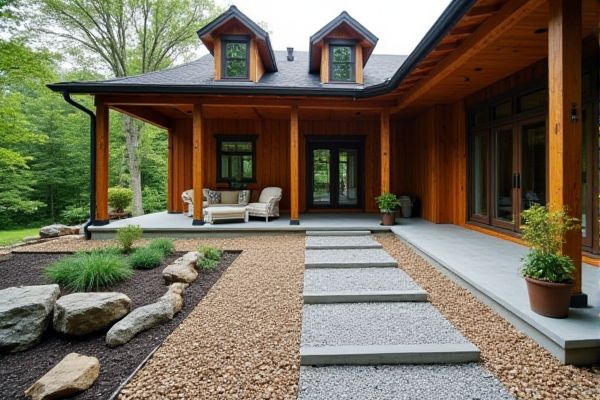
Pea gravel offers smoother texture and better drainage, making it ideal for walkways and garden paths, while decomposed granite provides a compacted, stable surface suitable for patios and driveways due to its firmness and natural appearance. Discover which material best fits Your landscaping needs by exploring the detailed comparison in the rest of the article.
Table of Comparison
| Feature | Pea Gravel | Decomposed Granite |
|---|---|---|
| Material | Small, rounded stones (typically 3/8 inch size) | Crushed granite rock particles, finer texture |
| Appearance | Multicolored, smooth, polished look | Earthy tones, mostly tan to reddish-brown, natural matte finish |
| Drainage | Excellent, water flows easily | Good drainage but can compact and reduce permeability over time |
| Stability | Loose, less stable for walking or wheel use | Compacts well, creating a firm, stable surface |
| Maintenance | Low, occasional raking | Needs periodic reapplication and compaction |
| Common Uses | Pathways, driveways, landscaping accents, drainage | Walking paths, patios, driveways, erosion control |
| Cost | Moderate, typically $40-$60 per ton | Generally lower, about $30-$50 per ton |
Introduction to Pea Gravel and Decomposed Granite
Pea gravel consists of small, rounded stones typically ranging from 1/8 to 3/8 inch in diameter, prized for its smooth texture and excellent drainage properties in landscaping and pathways. Decomposed granite is weathered granite that breaks down into fine particles and small gravel, offering a solid yet porous surface ideal for driveways, walkways, and garden beds. Both materials provide durable, visually appealing options for outdoor projects but differ significantly in texture, compaction, and installation requirements.
Key Differences Between Pea Gravel and Decomposed Granite
Pea gravel consists of smooth, rounded stones typically ranging from 1/8 to 3/8 inch in diameter, offering excellent drainage and a loose texture ideal for walkways and landscaping. Decomposed granite is a finely crushed, compactable material that provides a firm surface suitable for patios and pathways, with superior stability compared to pea gravel. Your choice depends on the desired aesthetic, surface firmness, and maintenance requirements for your outdoor space.
Appearance and Texture Comparison
Pea gravel features smooth, rounded stones in various earthy tones, offering a polished and casual aesthetic perfect for walkways and garden accents. Decomposed granite consists of finely crushed granite particles, creating a compact, sandy surface with a warm, natural look ideal for patios and paths. Your choice depends on whether you prefer the crisp contours of pea gravel or the softer, more uniform texture of decomposed granite.
Installation Processes Explained
Pea gravel installation involves spreading a weed barrier fabric followed by leveling and compacting the gravel to create a stable surface for pathways or drainage areas. Decomposed granite requires excavation, then layering with a stabilizer or binder before compacting to form a firm, solid base suitable for patios or walkways. Both materials demand proper base preparation and compaction to ensure durability and prevent shifting over time.
Maintenance Requirements for Each Material
Pea gravel requires minimal maintenance, primarily involving occasional raking to keep the surface even and the removal of debris to prevent weed growth. Decomposed granite demands more upkeep, including periodic replenishing to address erosion and compaction, as well as regular watering or sealing to maintain stability and reduce dust. Both materials benefit from proper edging to contain the surface and prolong lifespan.
Durability and Longevity Factors
Pea gravel offers exceptional durability due to its rounded, smooth stones that resist erosion and compact well, making it ideal for high-traffic areas. Decomposed granite, composed of finely crushed granite, compacts tightly but may erode faster in heavy rainfall if not properly stabilized with binders. Your choice depends on the balance between maintenance requirements and the desired aesthetic, with pea gravel generally providing longer-lasting performance in most environments.
Cost and Budget Considerations
Pea gravel typically costs between $30 and $60 per ton, making it a more budget-friendly option compared to decomposed granite, which ranges from $50 to $125 per ton depending on quality and location. Installation costs also vary, with decomposed granite requiring a stabilizer or binding agent that can increase expenses, whereas pea gravel generally involves simpler groundwork and less preparation. For projects emphasizing affordability, pea gravel offers lower upfront and maintenance costs, while decomposed granite may demand a higher initial investment but provides a more compact, erosion-resistant surface.
Best Uses: Landscaping, Pathways, and Beyond
Pea gravel excels in landscaping and pathways due to its smooth texture and attractive appearance, making it ideal for garden beds, walkways, and decorative ground cover. Decomposed granite offers superior compaction and stability, making it well-suited for driveways, patios, and erosion control in high-traffic areas. Both materials enhance drainage and reduce soil erosion, with pea gravel favored for aesthetic softscaping and decomposed granite preferred for durable, hardscape applications.
Environmental Impact and Drainage
Pea gravel offers superior drainage due to its rounded, smooth particles that allow water to flow freely, reducing runoff and soil erosion. Decomposed granite compacts more firmly, providing moderate drainage while stabilizing surfaces and minimizing dust, but may contribute to slight water retention. Both materials are natural and environmentally friendly, with pea gravel being more effective in promoting groundwater recharge and decomposed granite enhancing erosion control in landscaping projects.
Choosing the Right Material for Your Project
Pea gravel offers excellent drainage and a smooth texture, making it ideal for walkways and decorative pathways, while decomposed granite provides a compact, stable surface perfect for driveways and patios. Your choice depends on the desired appearance, functionality, and maintenance requirements of the space, with pea gravel being easier to install but prone to shifting and decomposed granite offering greater durability and a natural look. Consider factors such as erosion control, weight capacity, and budget to select the best material for your project's specific needs.
 homyna.com
homyna.com